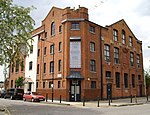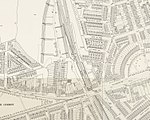The Favourite (pub)
20th-century architecture in the United KingdomDemolished buildings and structures in LondonFormer pubs in LondonHolland ParkPubs in the London Borough of Hammersmith and Fulham

The Favourite was a pub at 27 St Anns Road, Holland Park, London W11, that closed in 2011. A pub had existed on the site since at least 1879. The building was demolished and replaced by a six-storey block of studio flats around 2012.
Excerpt from the Wikipedia article The Favourite (pub) (License: CC BY-SA 3.0, Authors, Images).The Favourite (pub)
St. Anns Road, London Notting Hill (London Borough of Hammersmith and Fulham)
Geographical coordinates (GPS) Address Nearby Places Show on map
Geographical coordinates (GPS)
| Latitude | Longitude |
|---|---|
| N 51.5086 ° | E -0.2159 ° |
Address
Yara Central Holland Park
St. Anns Road 27
W11 4DQ London, Notting Hill (London Borough of Hammersmith and Fulham)
England, United Kingdom
Open on Google Maps










